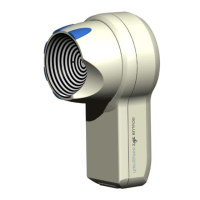Instruction Manual Easygraph
Page 37
ISV = Index of Surface Variance. Gives the
deviation of individual corneal radii from the
mean value. Elevated in all types of
irregularity of the corneal surface (scars,
astigmatism, deformities caused by contact
lenses, keratokonus etc.).
IVA = Index of Vertical Asymmetry. Gives the
degree of symmetry of the corneal radii with
respect to the horizontal meridian as axis of
reflection. Elevated in cases of oblique axes
of astigmatism, in keratoconus or in limbal
ectasias.
KI = Keratoconus-Index. Elevated especially in
keratoconus
CKI = Center Keratoconus-Index. Elevated
especially in central keratoconus.
RMin = Gives the smallest radius of curvature in the
entire field of measurement. Elevated in
keratokonus.
IHA = Index of Height Asymmetry. Gives the
degree of symmetry of height data with
respect to the horizontal meridian as axis of
reflection. Analogous to IVA, though
sometimes more sensitive.
IHD = Index of Height Decentration. Calculated
from a Fourier analysis of height values this
index gives the degree of decentration in
vertical direction. Elevated in keratokonus.
ABR = Aberration coefficient. Calculated from
Zernike analysis output. If there are no
abnormal corneal aberrations, ABR is 0.0,
otherwise ABR becomes 1.0 or greater,
depending on the degree of aberration.
KKS = Keratokonus Stage. Based on topometric
measurements, this index follows the clinical
findings of Amsler’s classical staging
schema.
AA = Analyzed Area. Gives the area of the
corneal surface actually measured (as
opposed to merely interpolated) as a
percentage of the entire measuring field.
The instrument compares the measured values with
the mean values and standard deviations of a normal
population. Measured values which exceed the
standard deviation by a factor of more than 2.5 are
classified as abnormal and highlighted in yellow.
Pathological values, i.e. values that exceed the
standard deviation by a factor of more than 3, are
highlighted in red.
Clicking in the “Indices” field causes a window to
appear containing explanations of the index
abbreviations (ISV, IVA,...).
Index limit values:
Index Abnormal
(yellow)
pathological (red)
ISV
∏37 ∏41
IVA
∏0,28 ∏0,32
KI >1.07 >1.07
CKI
∏1,03 ∏1,03
Rmin <6,71 <6,71
IHA
∏19
>21
IHD
∏0,014
>0,016
ABR
∏1 ∏1
The “Progress of Indices” field (below) lists the
indices from all examinations performed up to the
present on each eye. In this way indices from old
and new examinations can be readily compared for
each eye. If more than four examinations have been
performed per eye, the program will provide a
Windows slider control for selecting those to be
displayed. The currently loaded measurement is
highlighted with a blue frame. Note Ö Examinations
listed in the “Progress of Indices” field can be
loaded directly by double clicking.

